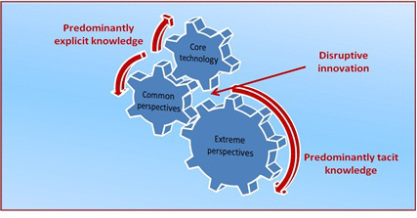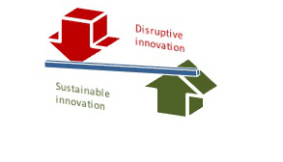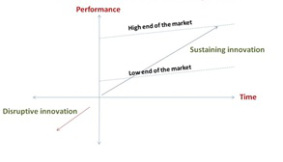The Disruptive Machine – an extension of Clayton Christensen Principles
 With the advent of the 21st century, it has become extensively recognised that economically the current state of affairs amongst corporate institutions remains in profound turmoil.
With the advent of the 21st century, it has become extensively recognised that economically the current state of affairs amongst corporate institutions remains in profound turmoil.
In order to simplify organisational complexities and as an extension of the Clayton Christensen principles, I am probing that established organisations (corporates) thus far are in actual fact perhaps for the first time in a position to consider absorbing the concept of disruptive innovation on a scientific basis and for this to be applied in a systemic way.
This paper starts with a retrospective view of the history of innovation, its incubation, periods of economically revolutionary change and how cultural, geographic and political influences gave rise to the evolution of global organisations. It then goes on to explain the face of innovation setting a cultural consensus that could mean for the global 2000 in terms of a new incentivised direction.
Settling
(a) From a retrospective view: “History of innovationâ€
The field of Economics has been evolving in major sequences over identifiable periods. Often these periods were turbulent in the corporate sense, marked by revolutionary characteristics; incl. e.g. organizational collapses, bankruptcies, hostile takeovers, reverse takeovers, etc. After a long incubation period, the first such economic revolution took place in the UK in the 19th century based on religious roots. Then, during the mid 20th century, Taylorism took over systemic European progress into the USA, mainly in the wake of forced actions related to WWII. In the late 20th century, a third cultural mindset originating in Japan started superseding most existing Western economic practices with the introduction of the Just In Time (JIT) management concept. This change was driven by strong cultural and organizational perspectives, mostly originating in Japan. Back in Europe, a number of events. incl the end of the Berlin wall, a political outcome, marked the beginning of what was truly the opening of the global market into an emerging “standard social cultureâ€.
Based upon the long lasting evidence of Kondratieff’s economic cycles of 50 year periods in terms of product life cycles, the advent of the 21st century was about to bring its new long term economic specifics. It has now a name: disruptive innovation.
(b) From an economic point of view: “the face of innovation-visible innovation consensusâ€
b.i During the aforementioned period i.e since WWII, the world economy has witnessed the appearance of numerous massive corporate institutions, easily numbering over 100,000 employees or more, at the same time demonstrating considerable economic value often competing in size even with the GNP (Gross National Product) of certain smaller countries (e.g. Belgium, Netherlands, Denmark). For clarity, these companies today generally can be categorized as forming part of the “global 2,000â€in terms of capitalization, turnover, number of employees. Such organizations have de facto become the visible innovation consensus of the world operating across all industry sectors. From observation, we are familiar with and can easily account for a handful of players in each of the major market segments e.g FMCG (fast moving consumer goods), automobiles, computers, aircraft manufacturing, retail, oil & gas, pharmaceutical & medical, etc.
b.ii These companies have been concentrating over decades on the competitive advantages (patterns or technical sum of knowledge assembled in a specific way) by applying a constant focused effort that ultimately has brought sustainable success. In a period of regional competition (how it often started), success of economic significance was predominantly the outcome of established localized architecture hand in hand with financial corporate networks enjoying “niche geographiesâ€. Globalisation and its “assertive competition†seeking economies of scale subsequently obliged global 2000 corporates to improve efficiency at all levels of the organization to remain competitive. However such strategy has been found to be void on long term perspective.
b.iii Meanwhile, short-term economic ROI requirements have forced corporate organizations to reconsider their overall market positioning and R&D. To sustain, growth and innovation have become of paramount importance. Yet, we acknowledge that these efforts are initially undertaken in an intuitive exploratory manner. This means that we can arguably maintain cumulative unsuccessful efforts, keeping the organization in its usual model (albeit inevitably shrunken by the competitive complexity of a modern economy incl. having to deal with e.g. the volatility of rapidly changing consumer behavior and effects on market share).
Retrospectively, Thomas Edison made considerable efforts to discover the well known legendary innovation of the light bulb.He was satisfied to fail in his initial attempts simply because he understood where by trial and error he had been excluding wrong exploratory runs. However, in contrast with today’s corporate drivers, Thomas Edison had a strong intrinsic motivation i.e not time-bound, thus taking a remarkably different stance from the currently predominant ROI incentive which is extremely short-term.
b.iiii Further, small players can enter a market and revamp large organizations with a brand new concept, embracing Clayton Christensen’s theory e.g outcomes being more affordable, more efficient with a very different set of performance criteria.
(c) From knowledge accumulation view: “the blood of innovationâ€
c.i With the advent of the knowledge economy, world data is now doubling every few years, leaving us with an inexhaustible supply of facts, models, and concepts at our disposal. Hence, knowledge inflation has become no doubt one of the most striking phenomena of recent times.
c.ii Knowledge consists of explicit and tacit knowledge. Researchers have identified that the tacit knowledge is approximately 300,000 times more important than the explicit knowledge (Langdon Morris. “The Innovation Master Plan.” Innovation Academy, 2011. Chapter 5, The Innovation Process, page 144). Tacit knowledge being embedded primarily in the culture gap, we can interpret here the possible range of challenges to transform the existing usual business models into a more comprehensive structured framework embracing the newly emerging global standard social culture as already is taking hold amongst the Global 2000 referred to earlier.
c.iii Despite this apparent progress, management of corporate knowledge has not brought further defined management standards so far. Indeed, every other day, we can see the failure of corporate organisations to acquire, develop or deliver further knowledge production that could be of economic significance. For the “sluggish†global 2000 (-and by market linkages even the smaller sized organizations-) intuitive exploration time effort tend to take longer than it would in certain cases for e.g. a serendipitous or “lucky†disruption outsider.
Status
(d) Consequently, today’s world economy finds itself trapped in a transformational state. Corporates are still engaged in the tyranny of short term profit. They generally seem to have no clear idea or direction how to reinvent themselves. Innovation should be the mere avenue of a required transformation but it is often prevented achieving this by not being able to obtain measurable results beyond the incremental level.Different internal perceptions of what good work habits, best practice, and risk management constitute generally play a role in this. Hence, corporates continuously postpone a perceived major risk of suffering disruption.
(e) International leaders are aware of the disruptions in today’s corporate economies and impact this may have on the economy at large.Obviously there is a willingness to curtail this risk. Ambidextrous management of “embarrassing critiques†becomes often the vein of this dynamic. Indeed, in the extreme, some corporates have been known to introduce a competitively thinking company unit within their own organization. Even so, they do not have access to a comprehensive and effective management system that could be applied on a consistent basis.
(f) Consequently, we can challenge current global business awareness with the two following fundamentals.
f.i Economical change : “Business efficiency alone is no longer a determining competitive differentiatorâ€
f.ii Cultural change : “Business reality is a continuous negotiation of interpretation, starting from a cultural consensusâ€.
(g) Paradigm shift
Visionary

g.i The global economy is left in historically unprecedented turmoil mainly due to false expectations with regard to sustainability.
g.ii Disruptive innovation is a time equilibrium between explicit excellence and tacit complexity.
g.iii Innovation is a “state of knowledge†that organisations pack into patterns, later to be marketed internally with the support of an efficient management organisation. In an emerging global consensus world as described, innovation of disruptive scale is available technically at the wealth of approximately300,000 times the size of its existing importance (ref. state of knowledge). The former, being the knowledge status i.e the competitive advantage today, the latter, being the wealth of transformation opportunities possibly aligned to the global consensus, i.e. renewed economic growth tomorrow.
(h) New management framework
h.i If we return to the tried adage“We do not go to the beach to pick up mushroomsâ€, similarly, organizations operate within a familiar knowledge space. Indeed, on one hand there is the knowledge of economic significance (the visible market or explicit knowledge) and on the other its counterpart awaiting to embark (tacit knowledge available to fuse with explicit knowledge). Disruptions today therefore do operate in such knowledge space. In the absence of an appropriate framework, even mature well established companies sometimes can suffer exposure of their own very existence. Therefore, an organization owns an authentic knowledge space in which disruptive innovation can be identified on this principle.
h.ii Moreover, the “state of knowledge†(or again patterns or technical sum of knowledge assembled in a specific way) has nowadays often become compressed into a managed innovation process. It is a state of virtual 360° organizational readiness, fueling data on consumer behavior, core technology alignments, etc. All of these variables can be codified and are disruptive-convertible.
Clayton Christensen, USA

Alex Chenevier, UK

(i) From false expectations to a new economic standard
Tomorrow’s management of the global 2.000 and its significant market linked stakeholders may thus become a series of cumulative sequences of disruption capturing satisfactory levels of competitive ROI. This stage of transformation will offset the earlier so called efficient economy and model which predominantly applied a 360° explicit centric, efficiency centric but low ROI.Conversion is into a more tacit-centric global consensus based on actual disruptive sequences of high ROI usually obtainable from technology driven innovative breakthroughs.
image credits: Clayton Christensen; Alex Chenevier
Wait! Before you go…
Choose how you want the latest innovation content delivered to you:
- Daily — RSS Feed — Email — Twitter — Facebook — Linkedin Today
- Weekly — Email Newsletter — Free Magazine — Linkedin Group
 Alex Chenevier, is Founder or managiTecha and a DBA candidate. He can be reached at alex.chenevier@managitech.com
Alex Chenevier, is Founder or managiTecha and a DBA candidate. He can be reached at alex.chenevier@managitech.com
NEVER MISS ANOTHER NEWSLETTER!
LATEST BLOGS
Three things you didn’t know about credit cards
Photo by Ales Nesetril on Unsplash Many of us use credit cards regularly. From using them for everyday purchases to…
Read MoreFive CV skills of a business-minded individual
Photo by Scott Graham on Unsplash The skills listed on a CV help employers quickly understand your suitability for a…
Read More


